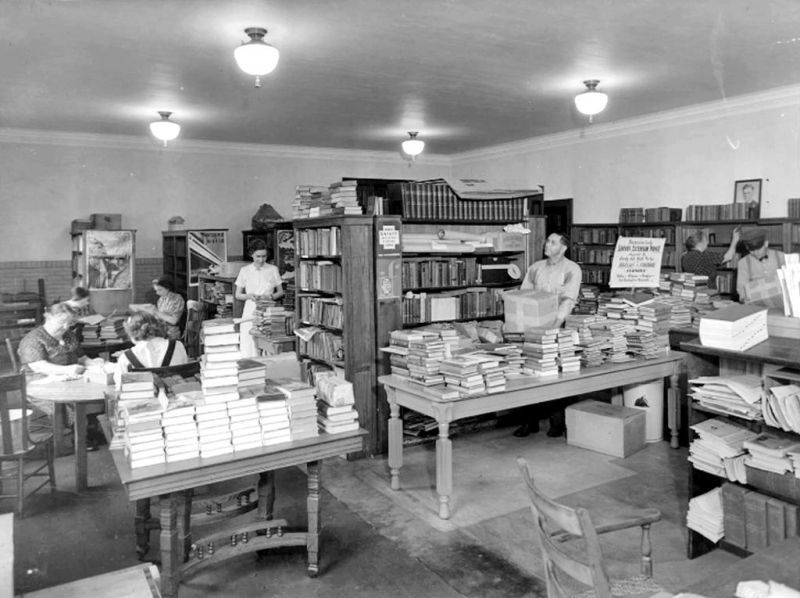WPA projects still in use today
Schools in Dover, New Philadelphia and Uhrichsville and numerous public institutions in the Tuscarawas Valley became the recipients of government funding during the 1930s Great Depression as part of the Works Progress Administration developed by President Franklin D. Roosevelt.
Dubbed the New Deal by the press and others, these programs built school buildings, stadiums, libraries and other buildings in the Tuscarawas Valley and throughout the U.S.
The Tuscarawas County Public Library System’s New Philadelphia Main Library was one of the most high-profile of the WPA projects in the area. The circulation of library books in New Philadelphia doubled in a period of six years, reaching 133,000 in the first six months of 1935. The public library also was the library for the county schools.
The new two-story building housed an auditorium seating 200 on the ground floor with a well-equipped stage and a research reading room, and on the first floor, there were adult and children’s reading rooms, a control room between the two, and the stack room.
The fire-proof structure’s exterior walls were faced with red brick trimmed with limestone. It was completed in December 1936 at a construction cost of $54,195 and a project cost of $57,876.
The Tuscarawas County Public Library also benefited from a WPA-sponsored program to provide library workers and collections to rural areas, starting in 1935. Two-hundred relief workers, mostly women, are employed by WPA travelling county libraries in 18 of the state’s counties.
These libraries serve CCC camps and more. Their stock of books and magazines is in excess of 75,000. Among the larger WPA travelling library projects in Ohio are those located in Wood, Belmont, Guernsey and Tuscarawas counties. Auto-trailers are a favored method of carrying travelling library books in most of Ohio’s counties.
Debra Tristano, in her 1990 Kent State University Master of Library Science thesis, indicated the Tuscarawas County Public Library, originally incorporated as the New Philadelphia School District Public Library, sought Tuscarawas County affiliation in order to take advantage of intangible tax and federal funding including WPA support.
Opening of library services to Tuscarawas County began in 1934, and the WPA grant for $25,781 was awarded in 1935. The library’s affiliation as the Tuscarawas County Library Extension Service was created by the State of Ohio and launched July 1, 1936.
The other major WPA project in New Philadelphia was Woody Hayes Quaker Stadium. It was completed in 1936. The original Quaker Stadium hosted its first game on Sept. 29, 1928, and was slated for upgrades.
Dover City Schools also benefited from multiple WPA-era projects including the still-operational Crater Stadium.
According to Dover City Schools’ website, “Dover was one of the many communities that realized benefits from the federal government through the WPA project in the 1930s. Dover Avenue Elementary building was remodeled at this time, and in 1936 an addition that housed a gymnasium and cafeteria was added to Dover Avenue.”
In 1936 Crater Stadium was built as part of the WPA project. The land upon which Crater Stadium sits was owned by the Crater family. The grandson, Harry Crater, gave the land upon which Crater Stadium was completed in 1937 to Dover City School District.
Also as part of the WPA project, the Oak Grove School, which previously sat in the area that is now the front lawn of the high school, was razed, and an addition to the high school was completed at a cost of $800,000.
This 1938 new addition to the high school provided instructional facilities for grades 7-12 of the district. An auditorium seating 1,300 was constructed as part of the school at that time and served as a community hub.
This new building, attached to the original 1915 Roosevelt High, became Dover High School and Sixth Street Elementary. It housed six elementary grades on the Sixth Street side, the original Roosevelt High wing and grades 7-12 in the remainder of the new facility.
Another WPA stadium project, Uhrichsville’s Claymont Stadium, was originally built by the WPA in 1937. It was recently demolished and replaced with a new facility. Construction costs to restore the brick façade and the desire to upgrade facilities were cited as reasons behind the decision to remove the WPA-built structures.
Preserved is a large mural that has hung in the foyer of the old Claymont High School for over 80 years. It was recently restored by the Claymont Community Center with help from the Claymont Historical Society and others.
In 1936 WPA-led repairs and construction work on public buildings provided 10,000,000 man hours of employment, of which almost a third were utilized on educational buildings.
About a sixth of the total employment was devoted to work on social and recreational buildings, over an eighth to improvement of grounds around buildings, and work on administrative buildings accounted for approximately a tenth. Most of the remainder was spent on charitable, medical and mental institutions; federal buildings; and housing projects. Wages averaged 63 cents per hour and were as high as 76 cents per hour.

